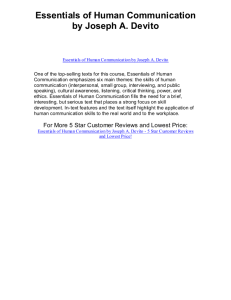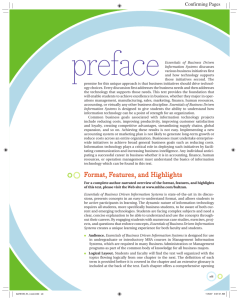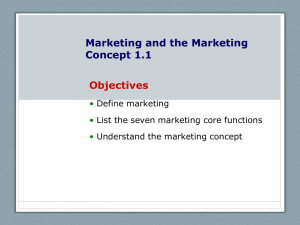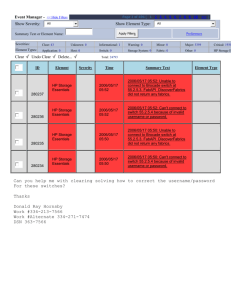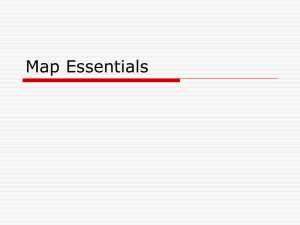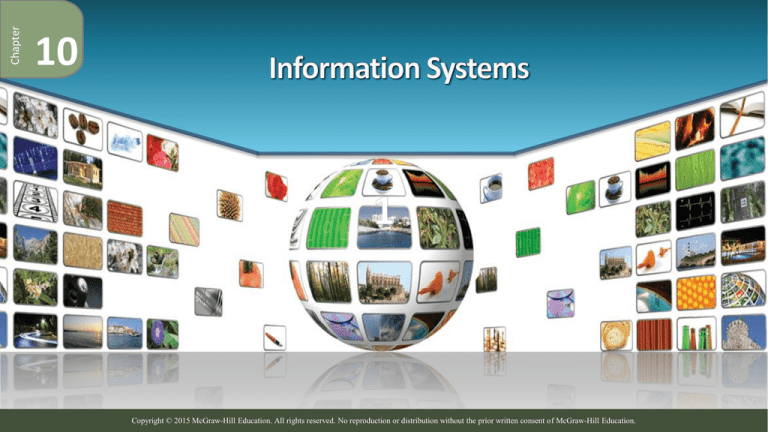
Chapter
10
Copyright © 2015 McGraw-Hill Education. All rights reserved. No reproduction or distribution without the prior written consent of McGraw-Hill Education.
Learning Outcomes
1. Explain the functional view of an organization and describe each function.
2. Describe the management levels and the informational needs for each level in an
Computing Essentials 2015
3.
4.
5.
6.
7.
8.
organization.
Describe how information flows within an organization.
Describe computer-based information systems.
Distinguish among a transaction processing system, a management information system,
a decision support system, and an executive support system.
Distinguish between office automation systems and knowledge work systems.
Explain the difference between data workers and knowledge workers.
Define expert systems and knowledge bases.
10-2
Introduction
• An information system is a collection of people,
procedures, software, hardware, data, and
connectivity
• They all work together to provide
information essential to running
an organization
• Computers are used in organizations to keep records
of events
Computing Essentials 2015
• Competent end users need to
understand how the information
flows as it moves through an
organization
10-3
Organizational Information Flow
• Information flows vertically and horizontally throughout an organization
• Information systems support the natural flow of information within an
Computing Essentials 2015
organization’s structure
• 5 Functional Areas
• Management Levels
• Information Flow
10-4
Five Functions of an Organization
Computing Essentials 2015
• Accounting
• Marketing
• Human Resources
• Production
• Research
Return
10-5
Management Levels
Computing Essentials 2015
• Management is usually divided into three levels: Top, Middle, and Supervisors
Return
10-6
Computing Essentials 2015
Information Flow
10-7
Computing Essentials 2015
Computer-Based Information Systems
10-8
Transaction Processing Systems (TPS)
Computing Essentials 2015
• Records day-to-day transactions in a database
• Also called data processing systems (DPS)
• One of the most essential uses of a TPS is in Accounting
10-9
TPS for Accounting
Computing Essentials 2015
• Sales order processing
• Accounts receivable
• Inventory and purchasing
10-10
Management Information Systems (MIS)
• Produces standardized reports to support decision-making by middle managers
• Integrates data and summarizes details from databases in a structured form
• Produces predetermined reports
Computing Essentials 2015
• Periodic reports
• Exception reports
• Demand reports
10-11
Decision Support Systems (DSS)
• Flexible tool for analyzing data for decision-making purposes
• Enables managers to get answers to unexpected and generally non-recurring
problems
• Reports do not have a fixed format
Computing Essentials 2015
• Microsoft Access is often used to provide an easy front-end interface
• Consists of four parts:
•
•
•
•
User
System software
Data
Decision models
10-12
DSS Decision Models
• Strategic models
• Assists top level management in long-range planning
• Tactical models
• Assists middle-management control the work
• Financial and sales promotion planning
Computing Essentials 2015
• Operational models
• Assists lower-level managers accomplish the daily activities and
objectives
10-13
Executive Support Systems (ESS)
• Designed for top management
• Sophisticated software for presenting, summarizing, and analyzing data, but
Computing Essentials 2015
specifically designed to be easy-to-use
• Provides immediate access to a company's key performance indicators
10-14
Other Information Systems
• Information workers
• Data workers
• Knowledge workers
• Office automation systems
Computing Essentials 2015
(OASs)
• Supports data workers
• Project management programs
• Videoconferencing systems
• Knowledge work systems (KWSs)
• Use specialized systems, such as CAD/CAM
10-15
Expert Systems
• Expert Systems
• Artificial intelligence
• Knowledge Base database
Computing Essentials 2015
• Systems developed in:
• Oil Spill Advisor
• Bird Species Identification
• Midwives Assistant
10-16
Careers In IT
• Information systems managers oversee the work of programmers, computer
specialist, systems analysts, and other computer professionals
• Employers look for individuals with strong technical backgrounds, with a Master’s
degree
• Strong leadership and
communications skills
• Information systems managers
Computing Essentials 2015
can expect to earn from
$92,000 to $125,000 annually
10-17
A Look to the Future ~ IBM’s Watson
• The Ultimate Information-
Computing Essentials 2015
Finding Machine
• As information amounts
increase, it is more difficult
to keep up
• Can Watson save us?
10-18
Open-Ended Questions (Page 1 of 2)
1. Name and discuss the five common functions of most organizations.
2. Discuss the roles of the three kinds of management in a corporation.
Computing Essentials 2015
3. What are the four most common computer-based information
systems?
10-19
Open-Ended Questions (Page 2 of 2)
4. Describe the different reports and their roles in managerial decision
making.
5. What is the difference between an office automation system and a
Computing Essentials 2015
knowledge work system?
10-20



